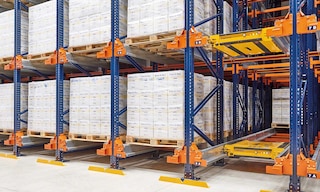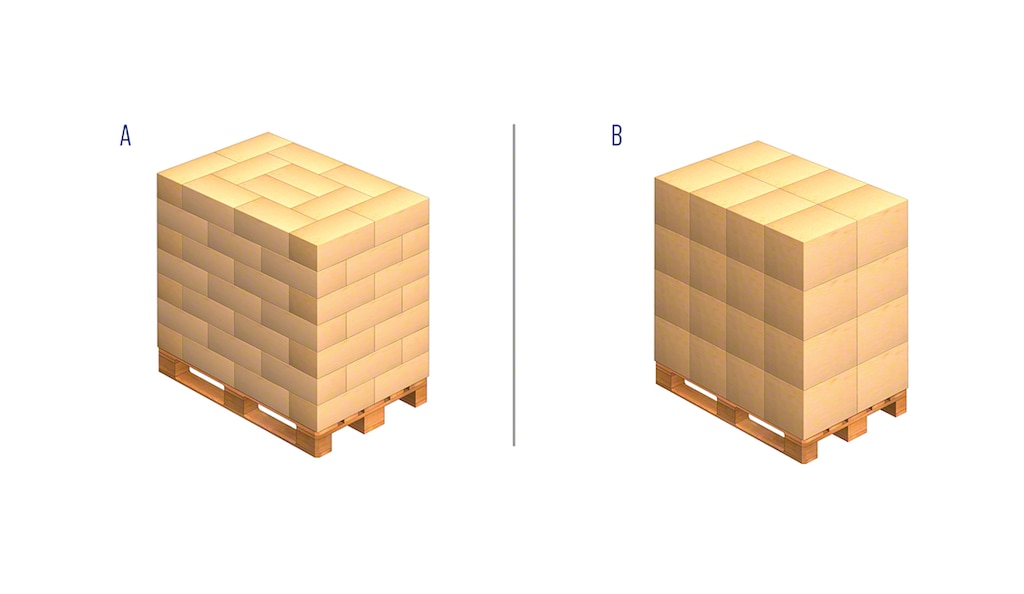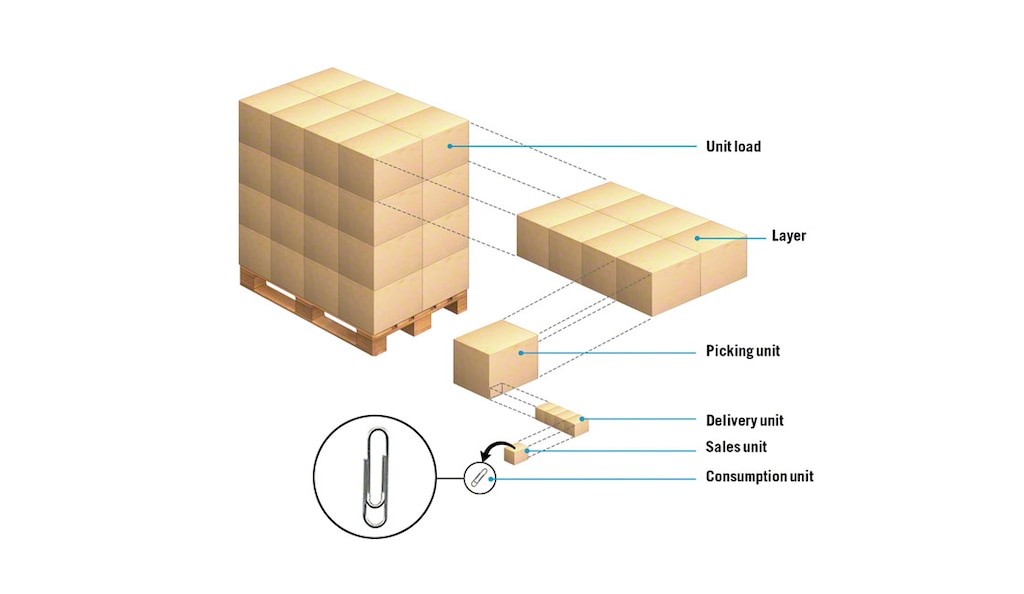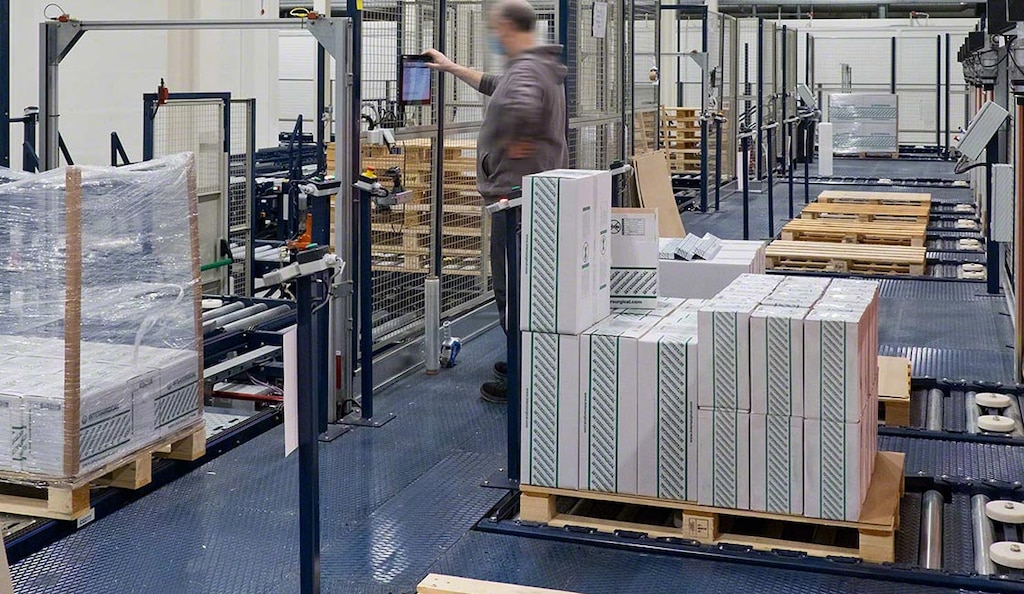
Palletizing goods: methods and benefits
Palletizing consists of grouping goods on a pallet to facilitate their storage, handling, and transportation. These platforms — usually made of wood — have the dual function of supporting the load and protecting the products: pallet racking keeps the goods in perfect condition throughout their logistics life cycle.
The use of pallets in logistics allows multiple unit loads to be assembled into a larger unit. Palletization makes it easier for operators to handle materials, as they can retrieve and deposit the entire load at the same time instead of having to move the products individually.
Proper palletizing is crucial to ensure the optimal performance of the facility. In automated storage and retrieval systems (AS/RS), in addition to ensuring the integrity of the products, it’s necessary to verify the good condition of the pallets so as not to damage the structure of the AS/RS. In warehouses with these kinds of systems, a checkpoint is usually set up to check the condition of the pallets before their storage.
There are many varieties of pallets of different sizes and materials on the market. In most cases, the choice of which one to use for palletizing depends on the characteristics of the product, the storage systems installed, and the handling equipment used in the warehouse.

What are the different palletizing methods?
Depending on the type of product, there are various ways of palletizing the goods. Regardless of the option chosen, the aim of palletizing is to enhance the stability of the load, avoiding loss of stock or damage to the material. These are the two main ways of palletizing:
- Interlocked boxes (A): the boxes are stacked in an interlocked manner, i.e., the arrangement of the boxes in each layer or layer is alternated to increase the stability of the load on the pallet.
- Stacked boxes (B): all units are stacked in the same direction, resulting in a completely homogeneous assembly.
During palletizing process, the pallet is often strapped with a plastic or steel strap to secure the load and prevent possible movement of goods during transportation. Alternatively, the shrink-wrapping technique can be used, which involves wrapping the cargo in plastic film to give it a more solid structure and make it easier to move.

Benefits of palletizing products
Palletizing goods in warehouses offers the following advantages:
- Optimization of storage space: grouping goods on pallets makes it possible to house a greater volume of products in the same space.
- Increased productivity: stacking products on a loading platform reduces the movements of operators and handling equipment, which can move a greater number of goods with each trip.
- Streamlined storage and retrieval of goods: palletized stock can be easily loaded and unloaded from the storage systems by means of suitable handling equipment.
- Control of stored stock: palletizing contributes to simpler inventory control by having a smaller volume of unit loads in the warehouse.
- Higher throughput in loading and unloading: the use of pallets allows operators — or automatic loading docks — to load and unload goods from trucks more quickly. Handling equipment can stack the goods and thus reduce the number of trips required.
- Integrity of the goods during transportation: the wrapping of the pallets prevents losses and damage to the packages or unit boxes during the distribution of the goods.
- Safety in manual and automated warehouses: palletizing limits the risk of damage and loss of stock while providing greater safety for goods, operators, and automatic equipment.

Tips for palletizing goods
Before palletizing the products, it’s important to select the type of pallet that best suits the needs of your business. Depending on the diversity of your company’s products, there are multiple loading platform options available based on their size (e.g., the GMA pallet or Euro-pallet) or construction material (mainly wood, plastic, or metal).
The use of square or rectangular pallets is a frequent choice because they’re easier to wrap, stack, and handle. When palletizing, the weight of the load must be distributed proportionally to ensure the stability of the assembly.
To palletize properly, you should be sure to use quality packaging and wrapping materials. The wrapping protects the products from damage during handling, storage, and transportation. It is therefore essential to seal all possible leaks in the wrapping to prevent air, water, or other liquids from entering and damaging the merchandise.

Palletizing materials for an agile and safe warehouse
Palletizing loads leads to more productive logistics operations. Most significantly, it ensures the integrity of the products during operations such as storage or the transfer of goods between different areas of the warehouse. Proper pallet racking is fundamental in automated warehouses: pallets in good condition enable the storage systems to function properly and limit the risk of stock losses or damage to the structure.
Interested in boosting your warehouse productivity and streamlining the flow of palletized goods? Don’t hesitate to contact us. One of our expert consultants will work with you to come up with the best solution for your company.
